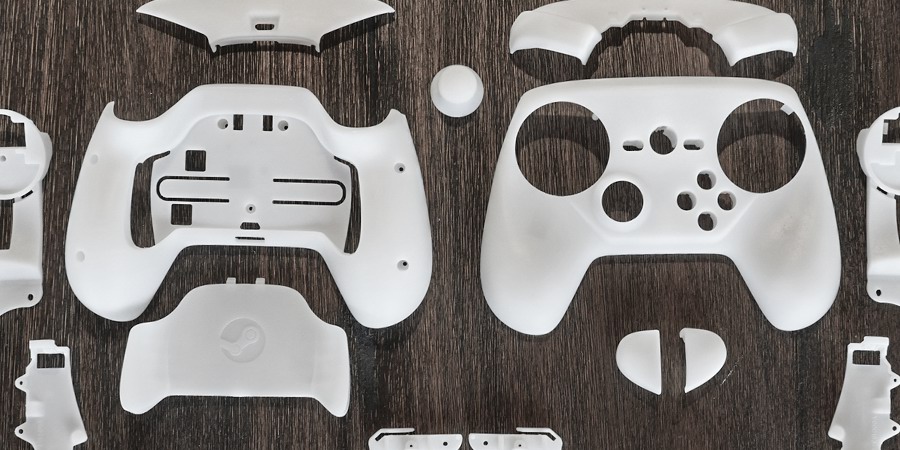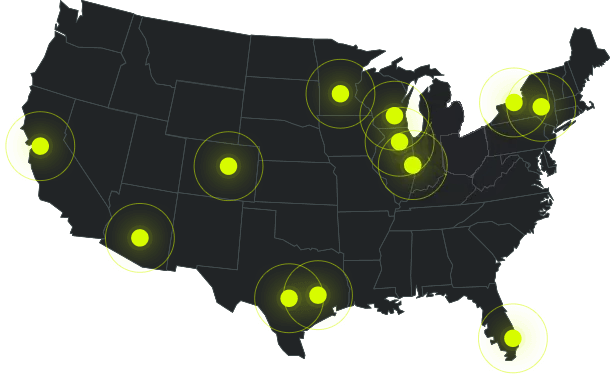SLA parts can have high impact strength, high temperature performance, water resistance, stiffness, and rigidity depending on the desired material. Talk to a Fathom expert to discuss material options today!
SLA Finishes
Fathom offers several finishing options for SLA parts. A Fathom expert can help you decide on the best finish for your project specifications. Our finishing services provide a one-stop-shop for all of your prototype and production needs including painting, texturing, engraving, and plating.
SLA Finishes //
- Strip & Ship //Supports are removed and minimally sanded in order to remove the support nubs left behind. Some nubs in hard-to-reach areas may remain. Build lines are visually present and the parts have a granulated/gritty texture.
- Sanded & Bead Blasted //Supports are removed, parts are bead blasted, and then sanded smooth. Build lines are somewhat present, but parts have a smooth texture. Bead blasted parts will make clear parts look frosty or cloudy.
- Rapid Paint //Supports are removed and then the parts are sanded and bead blasted. Paint is applied directly to parts without a primer. Build lines will be somewhat present through the paint.
- Rapid Clear //Supports are removed and then the parts are sanded and bead blasted. A basic clear coat is applied to parts. Build lines will still be somewhat present under the clear coat.
- Show Quality Paint //Supports are removed. Parts are bead blasted, and then extensively sanded until all build lines are removed. Primer is applied before painting. Customer will need to supply a pantone color or color chip. Parts are smooth and build lines are completely removed. Parts look as close to production quality as possible.
- Optically Clear //Supports are removed. Parts are bead blasted and extensively sanded until all build lines are removed. Multiple layers of clear coat are applied. Parts are smooth and build lines are completely removed. Parts are completely clear. Appearance is almost glass-like.
Applications of SLA 3D Printing //
Fathom has worked with businesses across multiple industries, providing 3D printing solutions to help innovate and meet production goals using SLA technology. Some applications of SLA include
//
- Medical Technology
- Educational Research
- Dentistry
- Engineering and Product Design
- Manufacturing
- Prototyping
What is the Difference Between SLA & SLS?
Stereolithography (SLA) is a 3D printing method using a thermoplastic resin that is cured by a UV laser. The laser is directed to specific areas of the resin bath. The UV laser will cure any resin it touches, creating a solid pattern. SLA is popular because it can print parts with great precision. The SLA process will only produce plastic parts. Complex parts will require support structures. These structures will need to be removed in post processing.
Selective Laser Sintering (SLS) is another 3D printing process that also uses a laser. The SLS laser is much more powerful and can sinter, or fuse together, particles to create a 3D part. SLS printers are commonly used for plastic, metal, glass, and ceramics. These materials are usually in powdered form. SLS does not require support structures as the unused powder around the part provides adequate support.
SLS machines use a very powerful laser. All SLS machines are entirely encased, blocking the view of the part as it is printed. SLA machines are typically enclosed in tinted glass or plastic. This allows the operator to view the part as it is being built. SLS printers build parts from powdered material that is considered easier to work with. SLA printers use a resin bath to build parts. Some resins may be toxic and hard to work with. Objects made by SLA machines are complex and detailed but can be brittle depending on the material choice. SLS parts are not as detailed, but still complex and are considered suitable for mechanical use.
Fused Deposition Modeling (FDM) vs. Stereolithography (SLA)
Fused Deposition Modeling (FDM) and Stereolithography (SLA) machines both build 3D printed parts layer-by-layer. FDM machines use a print head that extrudes heated plastic on to a build plate. FDM part quality, including smoothness and detail, will depend on the movements of the extruder and the extruder nozzle size. SLA is capable of producing accurate and smooth parts in almost any setting. The ability to make parts with finer details is why SLA may be preferred for specific projects.
SLA and FDM require differing degrees of post processing depending on the desired finish. FDM parts may need to be sanded to achieve a smoother surface. SLA parts have a sticky residue after being removed from the resin bath and must be washed with isopropyl alcohol. FDM can make parts out of the same materials used for injection molding. FDM is ideal for rapid prototyping or when extreme detail is not essential. SLA may lack the strength and durability of FDM, but it is a better choice for projects requiring intricacy and smooth surfaces. SLA is also an excellent choice for creating molds for casting.
Stereolithography Questions Answered
Q //What Finishes Are Offered Using SLA?
A
//Please refer to the list of finishes above.
Q //Can SLA Models Be Machined?
A
//Yes, SLA parts can be milled, drilled, tapped or lathed.
Q //What Geometries Are Best Suited For Stereolithography?
A
//SLA can be used for small and large parts. SLA can be used to manufacture parts that have tight dimensional tolerances and require smoother finishes.
Q //Is Stereolithography A Faster Process Than Fused Deposition Modeling?
A
//SLA is slower than FDM. The SLA printer laser has a smaller surface area and takes more time to complete each layer. FDM printers can lay down thicker layers with each pass, reducing the build time.
History of Stereolithography
Here is a summary of the history of Stereolithography
//
- 1970s //Dr. Hideo Kodama created the layered approach to Stereolithography and used ultraviolet light to cure photosensitive polymers.
- 1986 //Charles W. Hull patented Stereolithography and founded 3D Systems. The company would go on to commercialize stereolithography.
- 2011 // Desktop 3D printers utilizing SLA technology are launched.
Why Choose SLA 3D Printing?
SLA is an excellent choice for projects that require fine features, smooth surface finishing, part precision and accuracy, isotropy, mechanical attributes, water tightness or versatility of materials.
Advantages of stereolithography include
//
- Fine Features
- Smooth Finish
- Accuracy
- Material Versatility
- Design Freedom
- Water Tightness
- Isotropy
- Faster Turnaround Time
- Quick Design Changes
- Budget-Friendly
- Scalable
SLA offers a combination of high-quality resolution and surface finishes even at large volumes. SLA is also very effective at faithfully capturing the intricacies of the most complex parts. Clear SLA resins can achieve colorless clarity that mimics clear plastics with additional post processing. SLA is ideal for creating parts that may cost-intensive to produce using any other methods of manufacturing. SLA is consistently used for trade show models, aesthetic parts, and snap fits/functional assemblies.


